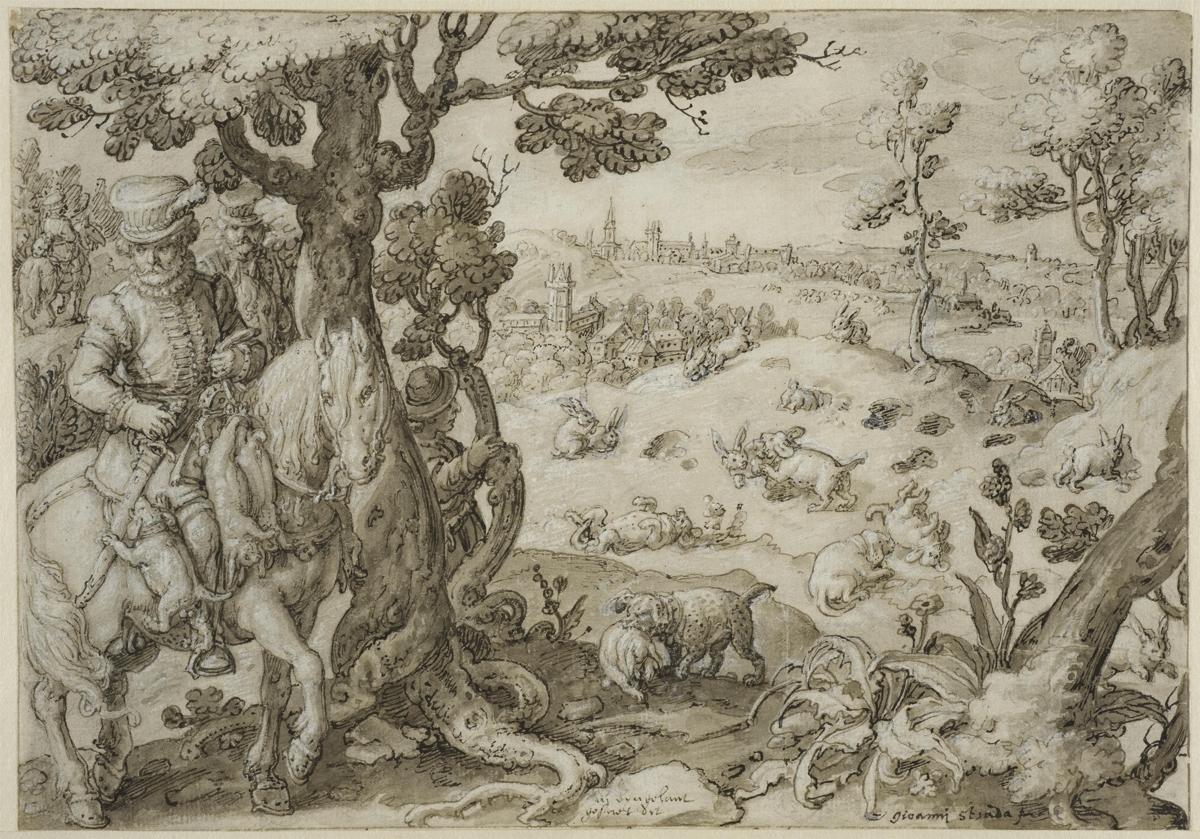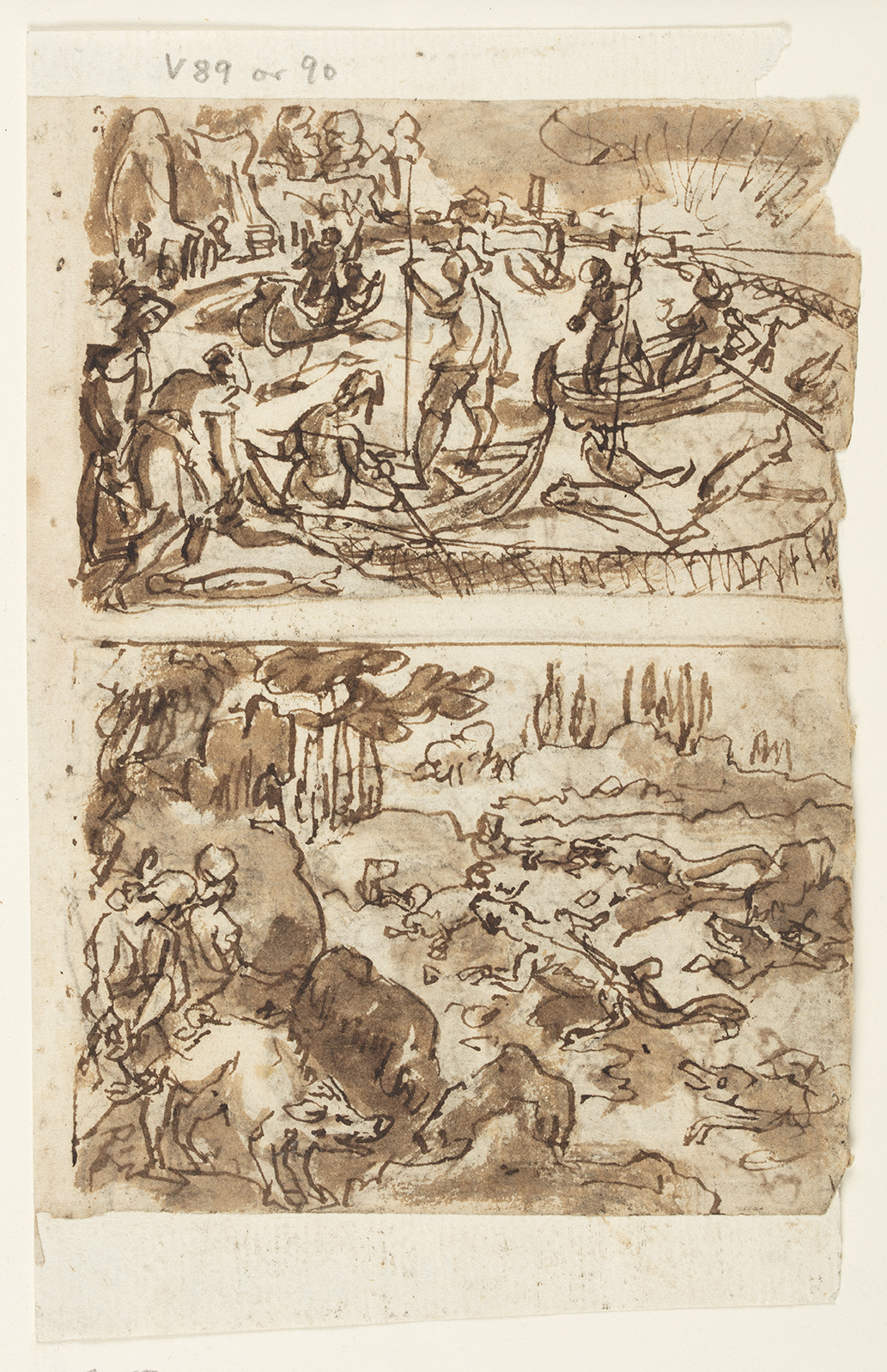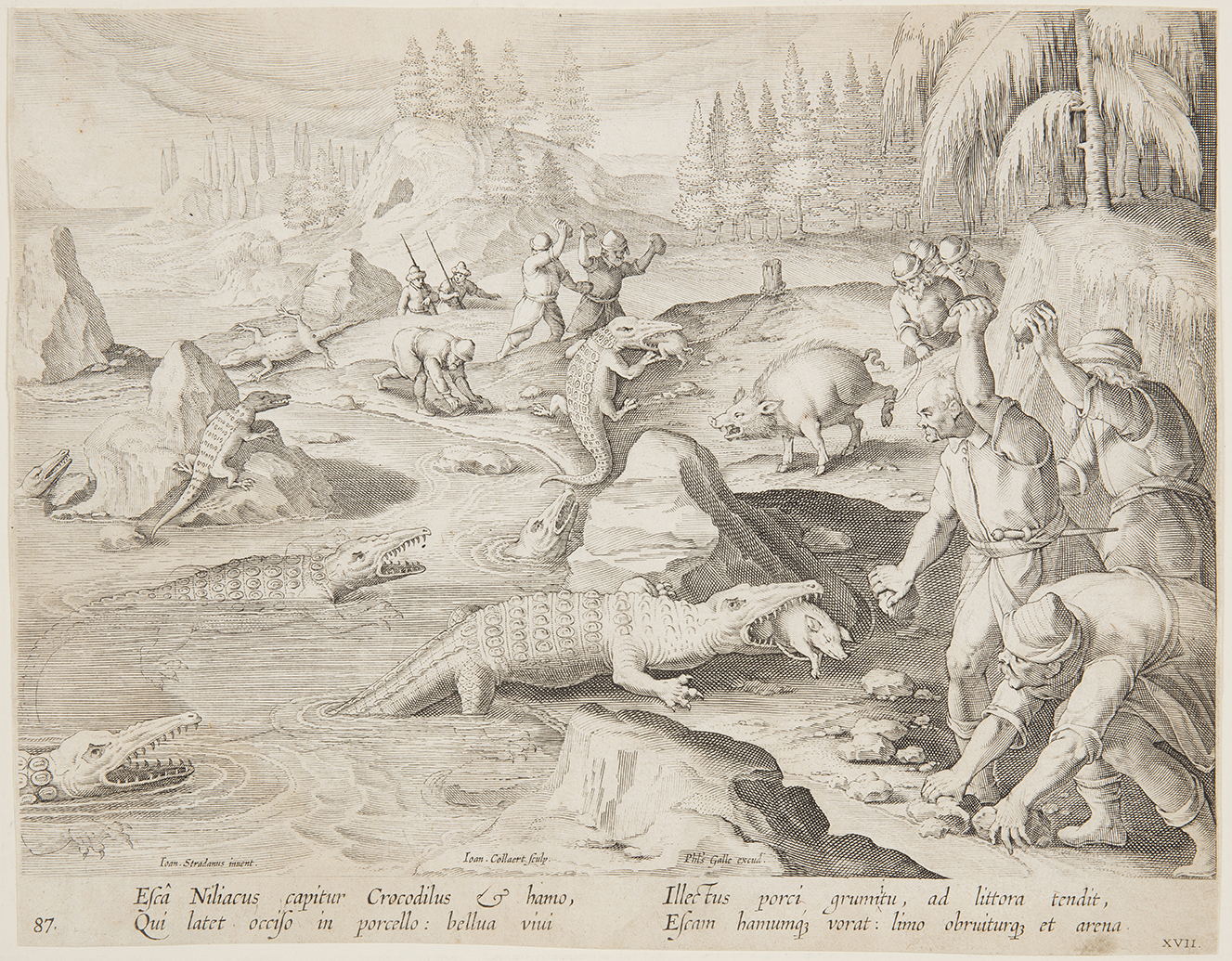Jan van der Straet, also known as Stradanus, was a late-Renaissance Flemish artist who spent most of his successful career in Italy, where he designed works—including paintings and tapestries—for the Medici court in Florence. Over the course of his lifetime, Stradanus also created numerous print series, which covered a wide variety of subject matters, including new technology and inventions, scenes from history, and religious narratives. Through these prints, his designs reached broad audiences across Europe, as well as Asia and Spanish colonies in the Americas, where the prints served as sources of inspiration for works of art such as carvings or paintings.
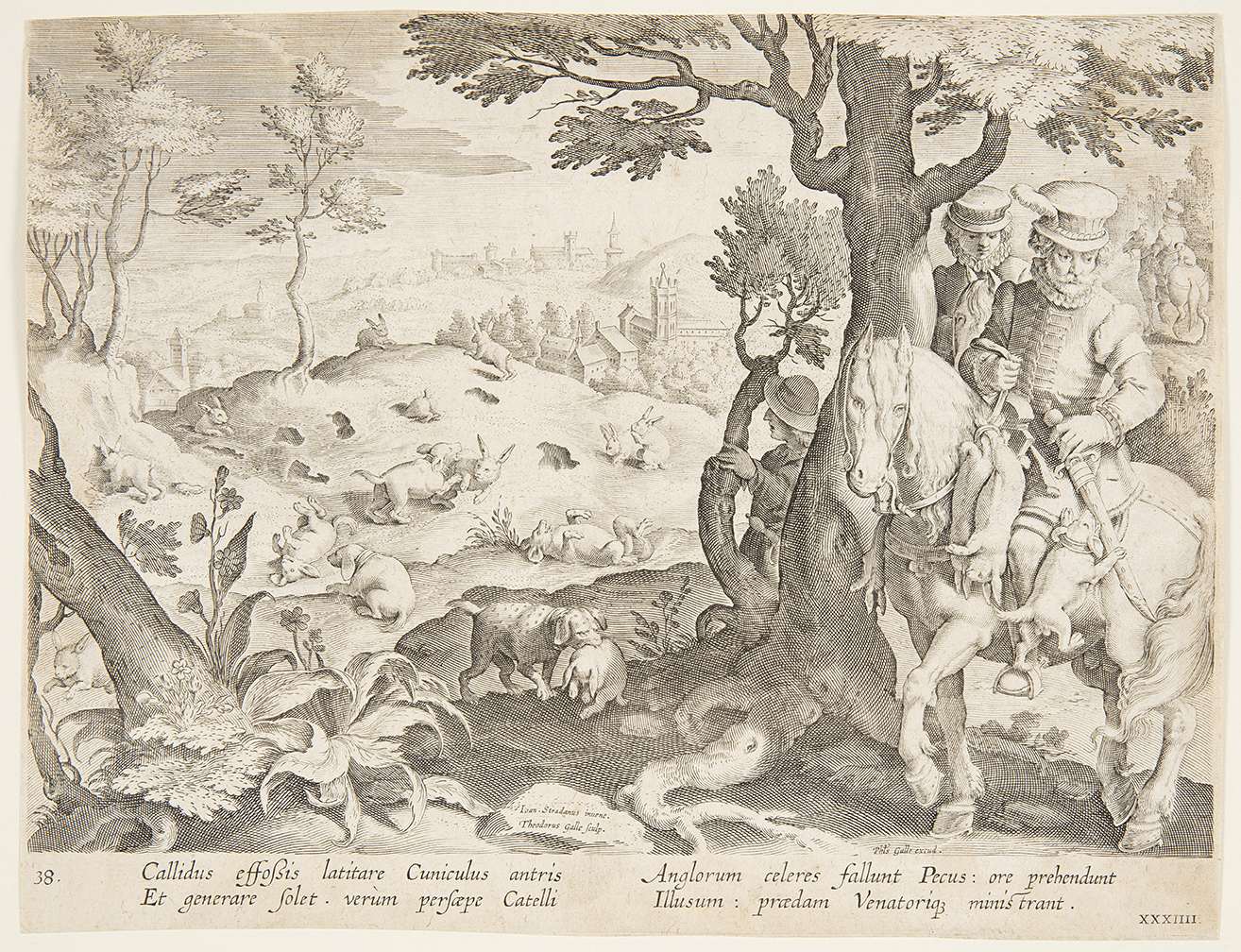
Figure 1: Print, The King of England Hunting Rabbits, ca. 1596; After Jan van der Straet, called Stradanus (Flemish, 1523–1605); Engraved by Theodor Galle (Flemish, 1571–1633); Published by Philips Galle (Dutch, 1537–1612); Engraving on paper; 29.9 × 26.3 cm (11 3/4 × 10 3/8 in.); Gift of Mrs. A. W. Erickson, 1952-37-11
Stradanus’s most famous prints depict various hunts, such as this example in Cooper Hewitt’s collection, titled The King of England Hunting for Rabbits (Figure 1), from the series Venationes, ferrarum, arium, piscium (The Hunts of Wild Animals, Birds, and Fish). Stradanus had originally created a set of hunting scenes for a group of tapestries that were made to decorate the Medici villa at Poggio a Caiano and were woven between 1566 and 1577. These designs were turned into prints, and due to their success, the artist created two more engraving series featuring different animal hunts, which include this work at Cooper Hewitt.
The scene depicts the king, mounted on horseback, as well as three other members of his party in a bucolic, outdoor setting. The king is featured most prominently, in the right of the foreground and next to a tall tree, which along with a tree trunk to the left, serves to frame the composition. The hunters are accompanied by hounds, which romp in the open meadow and chase rabbits emerging from their warrens. In the distance, Stradanus has included various buildings, which likely reference the king’s country estates.
The King of England Hunting for Rabbits features a complex composition that is the result of the artist’s creativity, but also the contribution of other collaborators. How did Stradanus and his associates make engravings such as these? How did an artist go about creating a print, and what was the process, from conception to finished work?
Examples from Cooper Hewitt’s collection can help illustrate this process. The museum is home to over 300 sketches by Stradanus. Groups of his drawings were bound together at some point to form sketchbooks, but later the sheets were separated, and many leaves were cut up. In the 19th century, the sketches entered the possession of collector Giovanni Piancastelli, who sold his collection to Eleanor and Sarah Hewitt, the founders of Cooper Hewitt. This group of drawings, which relate closely to Stradanus’s print projects, offers unique insight into the artistic process.
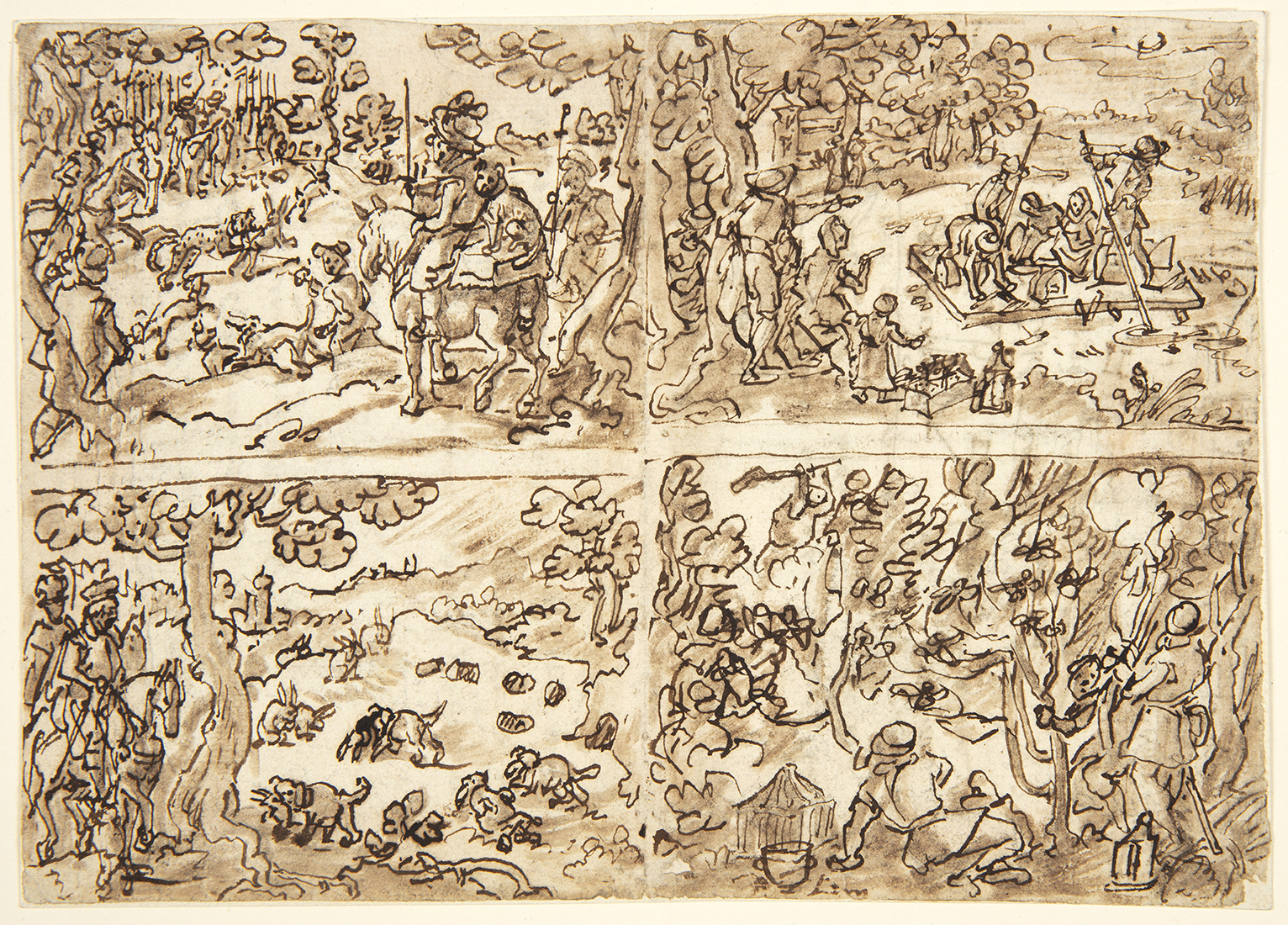
Figure 2: Drawing, Rabbit Hunt (above left); King of England Hunting for Rabbits (below left); Fishing by Night (above right); Catching Nightowls (below right), before 1596; Jan van der Straet, called Stradanus (Flemish, 1523–1605); Pen and ink, brush and brown wash over black chalk on laid paper; 14.9 × 20.8 cm (5 7/8 × 8 3/16 in.); Museum purchase through gift of various donors, 1901-39-133
Stradanus first recorded his ideas as sketches; these drawings served as the initial design, or “prima pensieri,” for the composition of his print. In the sketch made for The King of England Hunting for Rabbits, in the bottom left of this sheet at Cooper Hewitt (Figure 2), we can see how he has blocked out the figures, animals, and landscape elements with speedy strokes of the pen. Shadow is added through a broad and loose application of wash, while highlights are created by exposing the white of the paper. This quick and loose handling of ink and wash is seen in the other three sketches on this sheet, also made for engravings for The Hunts; as paper was costly in the 16th century, Stradanus conserved his materials by combining different sketches onto a single sheet.
After creating this initial sketch to work out his composition, the artist would often make a more finished drawing, or modello, based on it. In the version for The King of England Hunting for Rabbits (Figure 3), housed at the Nationalmuseum, Stockholm, we can see how Stradanus elaborated on his sketch. He created the modello knowing that it would ultimately serve as a template for the printmaker, the professional engraver Theodor Galle. Thus, the work is highly detailed to include textures, patterns, highlight, and shadow. Every individual figure and animal have been carefully delineated—even details of the background, such as the distant buildings with their roofs and towers, have been articulated. The pen line is much finer and more controlled, especially for the rendering of the main figure, the king of England, who wears an elaborate doublet with buttons. To indicate light, shadow, and volume, Stradanus has precisely applied wash or white heightening, while he has added pen hatching to create texture. Figures and forms in the foreground are outlined with darker pen line, while objects in the distance, such as the landscape and clouds, are rendered in lighter contours. This technique tells the printmaker to reproduce this tonal variation so that in the final print the foreground objects and figures stand out with greater immediacy.
After receiving the modello, printmaker Theodor Galle, a frequent collaborator of Stradanus, used a burin to engrave the design onto a copper plate. The plate was then inked and run through a press with a sheet of paper to create the final print. The finished engraving ultimately recreates the detail of the modello, as we can see how Galle took great care to render not only detail, such as texture, volume, and shadow, but also to reproduce the atmospheric effects of the landscape. The one major difference between the modello and finished print is that the engraving is the mirror image of the drawing, which is a result of the printing process.
However, in certain cases, the design process was not quite as seamless as it was for The King of England Hunting for Rabbits. For example, we can see how Stradanus changed his mind between the sketch and final print in Crocodile Hunt with Pigs as Bait. In the sketch (Figure 4, lower half of the sheet), Stradanus has placed two hunters and a large boar in the foreground and the crocodiles in the midground. But in finished print (Figure 5), Stradanus has replaced the boar with a crocodile, clambering on shore and with a piglet in its jaws. He has also expanded the group of hunters to include a third figure; each holds a rock over in his hands, in preparation to attack the oncoming crocodile. By making this change, the artist places greater emphasis on the exotic game, as well as a sense of impending danger as the reptile approaches the hunters. The final print also features more hunters, with rocks in hand, positioned in the midground.
Stradanus’s printmaking was also an international affair. Both the sketch and the modello were made in Italy by Stradanus, but the print itself was engraved in Antwerp, which was a major center for print and book publication. Stradanus’s prints were also published in Antwerp; Philips Galle, Theodor’s father and the owner of the large publishing enterprise, Aux Quatre Vents, served as a frequent collaborator to develop successful print series, such as Venationes, ferrarum, arium, piscium.
The finished prints, such as The King of England Hunting for Rabbits and Crocodile Hunt with Pigs as Bait, represent the complex process of facture, in addition to the international economic and social networks that were a key part of printmaking in the 16th century. As we continue to study the drawings from Cooper Hewitt’s sketchbooks, we hope to learn more about Stradanus’s working processes, collaborators, and sources of inspiration.
Jamie Kwan is Assistant Curator of Drawings, Prints & Graphic Design at Cooper Hewitt.
